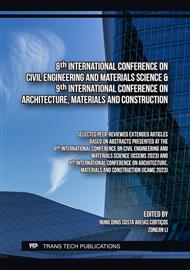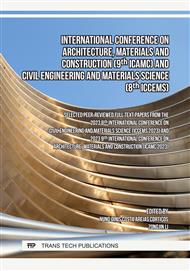[1]
Tsipianitis, Alexandros, and Yiannis Tsompanakis. "Improving the seismic performance of base-isolated liquid storage tanks with supplemental linear viscous dampers." Earthquake Engineering and Engineering Vibration 21.1 (2022): 269-282.
DOI: 10.1007/s11803-022-2083-6
Google Scholar
[2]
Wu, J. Y., Q. Q. Yu, and X. L. Gu. "Experimental Study on Seismic Behavior of Liquid Storage Tanks Subjected to Vertical Earthquakes." Proceedings of the 17th East Asian-Pacific Conference on Structural Engineering and Construction, 2022: EASEC-17, Singapore. Singapore: Springer Nature Singapore, 2023.
DOI: 10.1007/978-981-19-7331-4_16
Google Scholar
[3]
Asgari, M. H., M. I. Khodakarami, and R. Vahdani. "The Effect of Topographic Irregularities on Seismic Response of the Concrete Rectangular Liquid Storage Tanks Incorporating Soil–Structure–Liquid Interaction." Iranian Journal of Science and Technology, Transactions of Civil Engineering 44 (2020): 1179-1197.
DOI: 10.1007/s40996-019-00303-w
Google Scholar
[4]
Ren, Jiaqi, and Mohammadreza Vafaei. "Study on the Influence of Earthquakes with Different Frequency Content on the Peak Liquid Sloshing Wave Height of Liquid Storage Tank." Advances in Engineering Technology Research 4.1 (2023): 184-184.
DOI: 10.56028/aetr.4.1.184.2023
Google Scholar
[5]
Kumar, A. Vinod, et al. "Seismic behaviour of elevated liquid storage tanks by considering the different soil types using MATLAB software." Materials Today: Proceedings (2023).
DOI: 10.1016/j.matpr.2023.03.162
Google Scholar
[6]
Razzaghi, Mehran S. "Seismic performance of liquid storage tanks." Above Ground Storage Tank Oil Spills. Gulf Professional Publishing, 2023. 89-131.
DOI: 10.1016/b978-0-323-85728-4.00001-2
Google Scholar
[7]
Hosseini, Seyed Ehsan Aghakouchaki, and Sherif Beskhyroun. "Fluid storage tanks: A review on dynamic behaviour modelling, seismic energy-dissipating devices, structural control, and structural health monitoring techniques." Structures. Vol. 49. Elsevier, 2023.
DOI: 10.1016/j.istruc.2023.01.146
Google Scholar
[8]
Ministry of Housing and Urban-Rural Development of the People's Republic of China. "Code for investigation of geotechnical engineering (GB50021‐2001)." (2009).
Google Scholar
[9]
Tso, W. K., T. J. Zhu, and A. C. Heidebrecht. "Engineering implication of ground motion A/V ratio." Soil Dynamics and Earthquake Engineering 11.3 (1992): 133-144.
DOI: 10.1016/0267-7261(92)90027-b
Google Scholar
[10]
ANSYS, I. "ANSYS User's Guide." (2018).
Google Scholar
[11]
Livaoğlu, R., and Adem Doğangün. "Simplified seismic analysis procedures for elevated tanks considering fluid–structure–soil interaction." Journal of fluids and structures 22.3 (2006): 421-439.
DOI: 10.1016/j.jfluidstructs.2005.12.004
Google Scholar
[12]
EN 1998-4. "Eurocode 8-Design of Structures for Earthquake Resistance–Part 4: Silos, Tanks and Pipelines." (2006).
DOI: 10.3403/30047498
Google Scholar
[13]
Nilesh Warad, Janardhan Rao, Kedar Kulkarni, Avinash Dandekar, Manoj Salgar, and Malhar Kulkarni. "Finite Element Analysis Methodology for Additive Manufactured Tooling Components," International Journal of Engineering and Technology vol. 14, no. 4, pp.56-61, 2022.
DOI: 10.7763/ijet.2022.v14.1202
Google Scholar
[14]
Seismosoft. "SeismoSignal Version 2022" (2022).
Google Scholar



